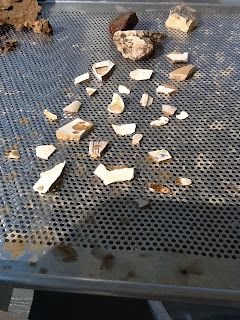Yesterday, we finished up the first field season for the SUNY-Orange archaeological field school. The last day was full of last minute profiles (four of them, most with standing stone walls on top), photos and finally backfilling of the last feature. All in all, we excavated 49 shovel test pits and four excavation units. I now have an office full of artifacts to catalog, identify and analyze...which I am looking forward to.

I'm still largely in the dark about what exactly what was going on at the site, but we already know a lot more than we did a month ago. Once the artifact analysis really gets going, we will get a good sense of the
when and
what of the site.
The site did have a number of features visible on ground surface, but very few surface artifacts (one barrel ring). Prior to the field class, my doomsday scenario was that we would find no artifacts (a sure fire way to make students uninterested in archaeology). Fortunately, that was not the case. I haven't yet tallied, but my ballpark estimate is that we recovered somewhere around 300 artifacts. Almost every excavation unit was positive for artifacts. The bulk of the recovered artifacts were historic ceramics, glass and metal, though we do have at least one clear lithic flake (there's a few questionable that are awaiting a date with a toothbrush).
All in all, I'm very pleased with how things went for this inaugural year, and hope and intend to continue for many years to come.
I'd like to thank the Orange County Land Trust for their permission and
enthusiastic support of the project. Their help is essential to this
and future projects. Having a cooperating land owner/manager makes all
the difference in the world. Of course, the project also wouldn't be
anything without the students involved, so thanks (in no particular
order) Brandon, Leah, Sean, Sean, Jordan, Daisy, Mike, Rich, and Joe.






















